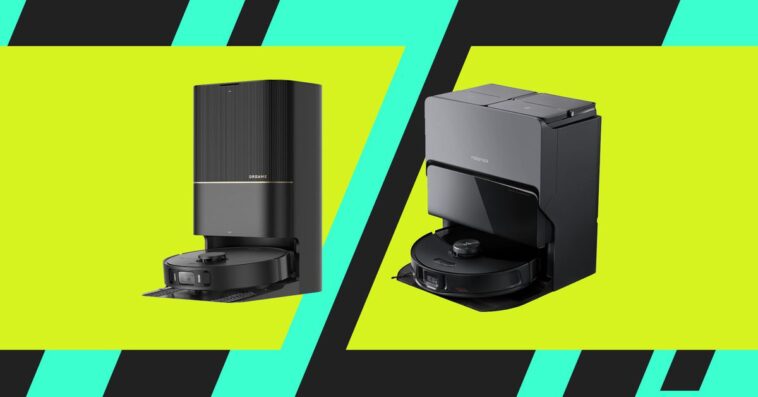### NAVIGATION AND OBSTACLE AVOIDANCE: THEY BOTH DODGED THE OBSTACLES
Both Roomba and Dyson vacuum robots are equipped with lidar technology that allows them to effectively map and navigate your home. During testing, both models swiftly and accurately mapped the house and responded well to room-specific cleaning requests without getting lost. The front-facing cameras on both robots enabled AI-powered obstacle avoidance, effectively evading fake objects like dog turds, socks, and cables.
While both models performed admirably, they did have some weaknesses. The Dyson vacuum robot successfully cleaned up a pile of Cheerios that the Roomba mistakenly identified as an obstacle. On the other hand, the Roomba struggled with avoiding pencils, which the Dyson handled without issue. Overall, both robots were rarely diverted from their tasks compared to non-camera-powered robots, highlighting the advantage of AI-powered obstacle avoidance systems.
This is a notable advancement for Dyson since the previous models used 3D obstacle detection, which was not as effective. However, Roombas with similar features are still considered superior in their ability to detect and avoid obstacles. Additionally, lidar-powered models like Roombas may misinterpret bed skirts or fabric as walls, whereas Dyson’s VSLAM-powered models can navigate underneath furniture more effectively.
The camera on the Roomba robot, although not always accurate, is a valuable addition for object detection. While the feature is not activated by default and requires specific actions to access remotely, it offers the potential for additional functionalities.
### VACUUMING POWER: STRONG PERFORMANCE FROM ROBOROCK
Both Roomba and Dyson vacuum robots boast powerful suction capabilities, effectively removing all types of debris from hard floors. However, the dual-brush system on the Roomba proved more effective on carpets, with its rubber roller design reducing hair tangles. While the Dyson vacuum robot includes a $50 anti-tangle tri-cut brush that eliminates tangles, the Roomba’s design inherently prevents hair from tangling without the need for extra accessories.
Furthermore, Roomba’s flexi arm is a valuable enhancement, specifically designed to enhance corner cleaning by extending the spinning brush to collect debris. Although the functionality of the flexi arm was not clearly visible during testing, the results indicated that it effectively cleaned the corners, showcasing its practicality in real-world scenarios.
Additionally, the introduction of auto-cleaning modes in high-end robot vacuums simplifies the cleaning process by automating specific cleaning routines for different areas in the home. Both Roomba and Dyson offer AI-powered cleaning modes, such as CleanGenius and SmartPlan, respectively, which streamline the cleaning process without the need for manual intervention.
These cleaning modes also include a feature that prompts the robot to revisit areas that require additional cleaning attention. While the effectiveness of this feature was challenging to evaluate comprehensively, it presents an intriguing aspect of robot vacuum functionality that warrants further observation. Ultimately, features that promote autonomous cleaning tasks offer convenience and efficiency for users.
### MOPPING PROWESS: DREAME’S INNOVATIVE MOPPING TECHNOLOGY
Dyson’s advanced mop pads, which automatically detach when transitioning to carpeted areas, represent a sophisticated solution to the challenge of maintaining cleanliness while vacuuming and mopping simultaneously. This unique feature ensures that the robot can effectively switch between cleaning modes without compromising the cleanliness of carpets.
Moreover, Dyson’s dual oscillating mop pads outperform Roomba’s single flat pad in removing wet spills and dried-on substances, demonstrating superior mopping capabilities. Although Roomba’s mop vibrates more frequently, Dyson’s mop pads effectively eliminated stubborn stains like ketchup and orange juice during testing, highlighting their effectiveness in addressing various cleaning challenges.
Furthermore, Dyson excels in cleaning baseboards and edges, utilizing its MopExtend RoboSwing technology to extend the mop’s reach and maneuver the robot towards tight spaces, ensuring comprehensive cleaning coverage. In contrast, Roomba’s Extra Edge Mop system, while offering some additional mopping reach, falls short of Dyson’s innovative approach to edge cleaning.
Dyson’s focus on efficient mop pad removal and extended cleaning capabilities underscores its commitment to enhancing the overall mopping experience. By incorporating advanced technologies and thoughtful design features, Dyson sets a high standard for robot vacuum mops in terms of performance and functionality.
### APPS, VIDEO CAMERAS, VOICE CONTROL, AND MATTER: THE FUTURE OF ROBOT VACUUM TECHNOLOGY
The implementation of sophisticated features in high-end robot vacuums, such as comprehensive control options via mobile apps, signifies a shift towards smart home automation. Both Roomba and Dyson offer extensive customization settings through their respective apps, allowing users to personalize cleaning routines and optimize performance based on their specific preferences.
However, Roomba’s app stands out for its refined interface, stability, and user-friendly navigation, providing a seamless user experience. With intuitive menus and reliable performance, Roomba’s app offers a superior level of control and accessibility compared to Dyson’s app.
Moreover, Roomba integrates voice control directly into its robot, offering a convenient and efficient user interaction experience. The inclusion of built-in voice command functionality, under the wake word “Hello Rocky,” enables effortless communication with the robot for various tasks, enhancing overall usability and convenience.
Additionally, Roomba’s support for Matter certification positions it at the forefront of smart home integration, paving the way for seamless connectivity with other smart home devices in the future. Roomba’s Matter-certified status enhances its compatibility and versatility, ensuring users are prepared for emerging smart home technologies and interoperability.
In conclusion, both Roomba and Dyson offer exceptional performance and innovative features in the realm of robot vacuum technology. While Roomba excels in vacuuming power, app functionality, and voice control, Dyson showcases advanced mopping capabilities and edge-cleaning technology. Ultimately, the choice between the two models depends on individual preferences and priorities in cleaning needs.





